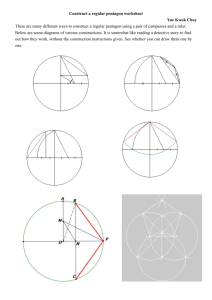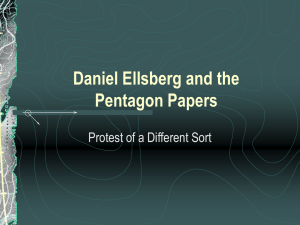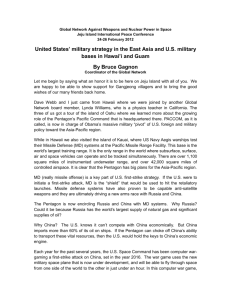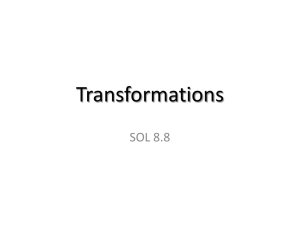Study_guide_answers_answers_unit_5
advertisement
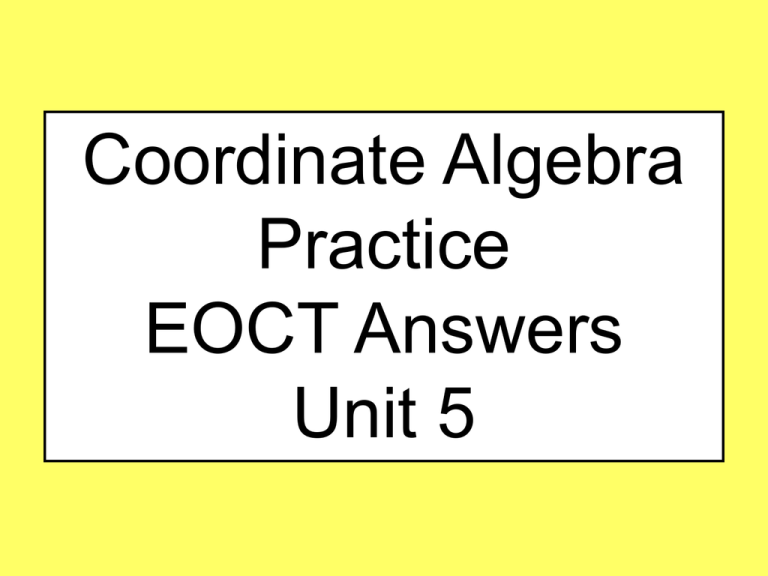
Coordinate Algebra Practice EOCT Answers Unit 5 #1 A regular pentagon is centered about the origin and has a vertex at (0, 4). Which transformation maps the pentagon to itself? A. a reflection across line m B. a reflection across the x-axis C.a clockwise rotation of 100° about the origin D.a clockwise rotation of 144° about the origin Unit 5 #1 A regular pentagon is centered about the origin and has a vertex at (0, 4). Which transformation maps the pentagon to itself? Unit 5 A. a reflection across line m m m #1 A regular pentagon is centered about the origin and has a vertex at (0, 4). Which transformation maps the pentagon to itself? B. a reflection across the x-axis Unit 5 #1 A regular pentagon is centered about the origin and has a vertex at (0, 4). Which transformation maps the pentagon to itself? C. B. a clockwise rotation of 100° about the origin Unit 5 #1 A regular pentagon is centered about the origin and has a vertex at (0, 4). Which transformation maps the pentagon to itself? D. a clockwise rotation of 144° about the origin Note: The pentagon is divided into 5 equal angles with a central point of rotation at (0,0). The sum of all 5 angles is 360°, representing one full rotation. a b e d c Unit 5 #1 A regular pentagon is centered about the origin and has a vertex at (0, 4). Which transformation maps the pentagon to itself? D. a clockwise rotation of 144° about the origin Since each angle has the same measurement, then the value of each angle is a b 360° 5 = 72° e d c Unit 5 A regular pentagon is centered about the origin and has a vertex at (0, 4). Which transformation maps the pentagon to itself? D. a clockwise rotation of 144° about the origin #1 Rotate 72° clockwise Unit 5 A regular pentagon is centered about the origin and has a vertex at (0, 4). Which transformation maps the pentagon to itself? D. a clockwise rotation of 144° about the origin #1 Rotate another 72° clockwise 72° + 72° = 144° Unit 5 #2 A parallelogram has vertices at (0, 0), (0,6), (4, 4), and (4, –2). Which transformation maps the parallelogram to itself? A. a reflection across the line x = 2 B. a reflection across the line y = 2 C. a rotation of 180° about the point (2, 2) D. a rotation of 180° about the point (0, 0) Unit 5 #2 A parallelogram has vertices at (0, 0), (0,6), (4, 4), and (4, –2). Which transformation maps the parallelogram to itself? C. A rotation of 180° about the point (2, 2) 180° Starting Rotation Points (–x,–y) (0, 0) (0, 0) (0,6) (0,–6) (4, 4) (–4, –4) (4, –2) (–4, 2) Add 2(2,2) = (4,4) (4, 4) (4,–2) (0,0) (0,6) Unit 5 #3 Which sequence of transformations maps ∆ABC to ∆RST ? A. Reflect ∆ABC across the line x = –1. Then translate the result 1 unit down. B. Reflect ∆ABC across the line x = –1. Then translate the result 5 units down. C. Translate ∆ABC 6 units to the right. Then rotate the result 90° clockwise about the point (1, 1). D. Translate ∆ABC 6 units to the right. Then rotate the result 90° counterclockwise about the point (1, 1). Unit 5 #3 Which sequence of transformations maps ∆ABC to ∆RST ? B. Reflect ∆ABC across the line x = –1. Then translate the result 5 units down. Starting Points Reflection on y-axis (–x,y) (–5,1) (–3,1) (–3,5) (5,1) (3,1) (3,5) Unit 5 #3 Which sequence of transformations maps ∆ABC to ∆RST ? B. Reflect ∆ABC across the line x = –1. Then translate the result 5 units down. Reflection on y-axis (–x,y) Add 2(–1)=–2 to each x-coordinate (5,1) (3,1) (3,5) (3,1) (1,1) (1,5) Unit 5 #3 Which sequence of transformations maps ∆ABC to ∆RST ? B. Reflect ∆ABC across the line x = –1. Then translate the result 5 units down. Add 2(–1)=–2 to each x-coordinate Shift down 5 units (3,1) (1,1) (1,5) (3,–4) (1,–4) (1,0) Unit 5
